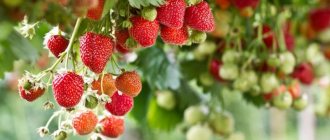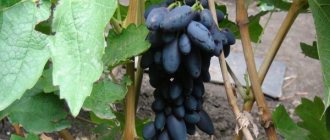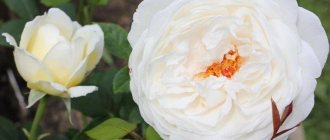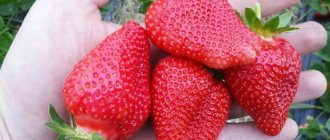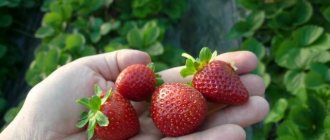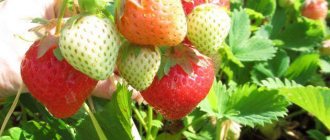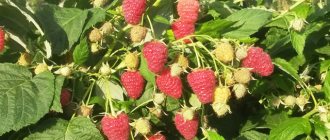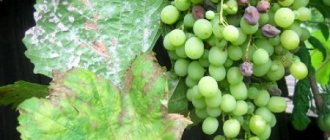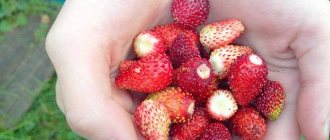Description
Bushes
Strawberry bushes of the Arosa variety, according to descriptions and reviews, are small with spreading leaves. The leaf blades are light green, slightly wrinkled. Pubescence is present along the edge of the leaf and on the petioles. Strawberry bushes grow quickly.
Peduncles are located above the foliage. The flowers are large, cup-shaped with a corolla. The formation of whiskers in the Arosa strawberry is average, but it is quite enough for propagation of the variety.
Berries
The fruits of the Arosa variety are orange-red, shiny, round-conical in shape, as in the photo below. The weight of one berry is up to 30 grams. The strawberry variety also has its own record holders, reaching a weight of 45 grams.
Scallops are sometimes observed on the first fruits (you can see them in the photo), all the rest are just regular in shape. There are seeds on the surface of the berries, they are slightly pressed in and are almost on the surface.
Important! The berries are dense, so they tolerate transportation well, which makes the Arosa variety attractive to merchants.
Gardeners in reviews note that sometimes the tips of berries at technical ripeness are not colored. This is not surprising, it’s just that the parent strawberry, Marmolada, had this feature. In fact, the berries of the Arosa variety are ripe and tasty, with sweet juicy pulp and a wine aftertaste.
There are up to 10 inflorescences on one plant, each of which blooms up to a dozen flowers. If agricultural practices are followed, up to 220 centners of delicious, aromatic berries of the Arosa variety are harvested from one hectare.
Attention! You can purchase seeds or planting material for strawberries of the Arosa variety from Becker, Gardens of Siberia and other online stores.
Advantages and disadvantages of the variety
It is not for nothing that the Arosa variety of strawberries is popular among summer residents and large agricultural producers. The product of Italian selection has a lot of advantages, but there are practically no disadvantages.
| Advantages | Flaws |
| First berry picking in mid-June, no harvest loss | With a lack of moisture, the berries become smaller and lose their taste. |
| Winter hardiness. In the southern regions they manage without shelter | Uneven ripening of berries: a new portion is harvested after a week. Although this factor is an advantage for many gardeners |
| High productivity – up to 220 c/ha | |
| Possibility of growing in open, protected ground and in pots | |
| Excellent taste properties | |
| Transportability | |
| Good resistance to many diseases |
Reviews from gardeners
Dmitry, 44 years old, Dzhankoy
I have planted Arosa since the spring of 2012. Bushes with good vigor, light green leaves, produce enough tendrils for propagation. The appearance of the plants and their main characteristics are very similar to the Clery variety. And this is understandable, because they are essentially “sisters”: both are of Italian origin. It is better not to plant them next to each other, otherwise it will be impossible to distinguish the daughter rosettes for seedlings. Surprisingly, the variety has short daylight hours and is non-repairing, but in our country it shows a tendency to bear fruit again. It bloomed in the fall and the berries began to ripen in early November. I don’t know how this will affect the yield next season.
Victor, 37 years old, Bashkiria
If you grow strawberries for sale, Arosa is a very suitable variety. The berry is beautiful, smooth, bright, shiny, dense, dry. For wholesale trade, it is better to collect at the initial stage of ripeness, while the tip is still uncolored, then it is easily transported and can lie quietly. Its taste, however, is not as rich and interesting as that of a fully ripened one, but still sweet and pleasant. On the forums, many praise it as a real find. I recently spoke with one hectare grower from Krasnodar, and he believes that of all the medium varieties he tried, there was nothing better than Arosa and so far there is none. He even more or less likes Asia, and with Clery he said that it turns out to be “outright sour.” Of the early varieties, I recommended exclusively Alba, and of the later varieties, only Malvina.
Raisa, 51 years old, Chelyabinsk region
Last year I bought several Arosa strawberry seedlings (Frigo, class A+) for testing. They took root well, bloomed profusely and for a long time. There were a lot of berries, I liked their taste and density. Well suited for eating, for whole fruit jam, and for freezing. I decided to keep this variety and try to propagate it. I read it on the Internet and did as advised: in the fall I cut all the leaves to a height of 4 cm, covered the bed with a layer of straw and covered it with lutrasil. Let's see how it survives the winter.
Nikolay, 49 years old, Izyum
Relatives from the Vinnytsia region shared Arosa seedlings. They grew it for two years, but were not too happy. They complained that despite all the advantages: yield, high percentage of marketable berries, transportability and visual attractiveness, there was practically no taste: no particular sweetness, no acidity. Perhaps it's because of their sandy loam soil. In my sandy soil, the taste of the berries was very good, but the plants turned out to be too painful. The bushes were somehow weak, constantly withered and disappeared, unlike other varieties, for which the care was similar. I threw it away without regret.
Reproduction methods
Experienced gardeners who are serious about strawberries monitor the bushes and rejuvenate the plantings in a timely manner. There are several ways to propagate a garden plant, and all of them are suitable for the Arosa strawberry variety.
Usami
Arosa strawberry bushes, according to descriptions and reviews from gardeners, do not produce a large number of mustaches. But the sockets on them turn out to be strong and viable. It is best to select several mother bushes and tear off the flower stalks from them. The mustache takes root on its own, although you can add soil. When the rosettes produce good roots, they are cut off from the mother bush and planted in a new place (see photo).
Dividing the bush
The bushes of the Arosa variety are powerful and grow quickly, so strawberries of Italian selection can be propagated by dividing the bush into several parts.
Growing from seeds
Propagation of strawberries of the Arosa variety by seeds, according to gardeners, is a completely acceptable procedure. It is worth noting that this method of obtaining seedlings is quite difficult and painstaking. Special rules and agricultural techniques must be observed.
Attention! Detailed information about seed propagation of strawberries.
Seed production technique and stratification
It is not necessary to buy Arosa strawberry seeds in the store. You can collect them yourself from ripe berries. To do this, cut off the skin along with the seeds and lay it out on a napkin in the sun to dry.
When the pulp dries, you need to gently knead the dry crusts between your palms, then winnow. The resulting seed material is placed in paper bags and stored in a cool place.
The seeds of the Arosa strawberry variety are difficult to germinate, therefore they require special preparation - stratification. It can be done in different ways:
- Place the soaked seeds in the refrigerator on the bottom shelf for 3-4 days.
- Place snow on the prepared soil and place strawberry seeds on top. Keep the container in the refrigerator so that the snow melts slowly. When the snow melts, the water will pull the seed along with it. It manages to stratify and produces vigorous shoots.
Sowing time
To obtain high-quality seedlings of the Arosa strawberry variety, seed sowing should begin at the end of January, beginning of February. During this time, the plants have time to gain strength, powerful strawberry bushes of the Arosa variety grow, which begin to bear fruit in the summer.
Sowing in peat tablets
It is convenient to grow strawberry seedlings in peat tablets. First, the tablets are soaked in warm water. When it swells, an Arosa strawberry seed is placed in the hole in the middle directly on the surface. Cover the top with film. Here they are, the sprouts, in the photo.
Sowing in the soil
For sowing, plastic containers are used, which are filled with nutrient soil. It is treated with a hot solution of manganese. The seeds are laid out on top and covered with glass or film.
Attention! Strawberry shoots of the Arosa variety, regardless of the growing method, are left under glass or film until 3-4 true leaves appear on the seedlings.
The shelter is opened slightly every day to ventilate the plantings.
Picking sprouts
Arosa strawberry seedlings grow slowly. Plants with 3-4 leaves dive. The soil is selected the same as when sowing seeds. You need to work carefully so as not to break the shoots. After picking, the strawberry seedlings are placed in a well-lit window. It is more convenient to work with plants grown in peat tablets, since the plants do not experience shock from replanting.
Comment! Light and warmth are necessary for Arosa sprouts at all stages of cultivation. If necessary, plants need to be illuminated, otherwise they will stretch out.
Why don't the seeds germinate?
Unfortunately, it is not always possible to wait for garden strawberries and strawberries to sprout. Most often the reason:
- in incorrect stratification;
- in deep seeding;
- in overdrying or excessive moisture of the soil;
- in low-quality (expired) seed material.
Features of the plant and fruiting
The bushes are quite compact - medium-sized, with sparse upright foliage. The leaves are light green with a slight glossy sheen, slightly wrinkled. Whiskers are formed in moderate quantities. Peduncles are long, located at the level of the leaves or slightly above. The flowers are white, bisexual, very rich in pollen, which ensures high fruit set and uniformity. Plants are distinguished by a strong tendency to repeat (continuous) spring flowering and an extended fruiting period. The first berries ripen around mid-June, 1-3 days later than “Marmalade”, according to reviews of Ukrainian gardeners, almost simultaneously with “Elsanta”. The process of fruit ripening occurs slowly, so harvesting is carried out once a week.
Long-term fruiting allows harvesting 4-6 times weekly
Commercial and consumer qualities of berries
The berries have very high marketability: they are large (on average 25-30 g), regular cone-shaped, even, smooth. The first fruits can gain weight up to 40-45 g and are often round, flattened or comb-shaped. At the stage of technical ripeness, the berries acquire a bright scarlet or orange-red color (not dark) and a pronounced shine, while the top remains lighter (whitish, greenish). The achenes are small, slightly pressed into the pulp. The pulp is medium density, light red, very juicy, sweet, with a classic strawberry aroma. According to reviews, Arosa strawberries have a good balance of sweetness and acidity and have a pleasant wine aftertaste. Tasting rating of fresh berries – 4.7 points (out of 5).
Ripe berries have a universal culinary purpose and tolerate long-distance transportation and long-term storage well.
The berries are universal in their purpose: they are well suited for fresh consumption, all types of processing, and also for freezing. The homogeneous consistency of the pulp and dense skin provide excellent transportability and keeping quality. The yield of the variety is called “record”, but it largely depends on the growing conditions and the intensity of agricultural technology. According to the originator, it is possible to obtain an average of 220 c/ha or about 1 kg of berries per bush.
Landing
Arosa strawberry seedlings, like other varieties of this crop, are planted in open ground in early May. If there is a threat of return frosts, shelter must be provided.
How to choose seedlings
The future harvest of aromatic berries depends on the quality of planting material. Strawberry seedlings ready for planting should have at least 5 leaves and a good root system. If any signs of disease are found on the plants, the seedlings are discarded.
If the seedlings were received by mail, then before planting they are soaked in water for a day and planted the next day.
Site selection and soil preparation
Arosa strawberries are planted in an open, well-lit area with fertile neutral soil.
The ridges are dug up, weeds are removed and watered with warm (about 15 degrees) water. It is better to plant strawberries after legumes, garlic, celery, carrots and onions.
Planting scheme
Strawberry bushes of the Arosa variety are compact, although tall. They are planted in one or two lines, depending on the area. The spacing between plants is 35 cm. When planting in two lines, the row spacing should be from 30 to 40 cm. This is what the beds with strawberries look like in the photo.
Attention! To understand the features of planting strawberries in open ground, it is useful to read the article.
Advantages and disadvantages of the variety
Arosa is a very hardy crop.
- It has a huge number of advantages compared to other varieties:
- no risk of crop loss;
- early ripeness;
- high productivity rates (about 2 t/1 ha);
- can grow both in the garden and at home;
- high taste indicators;
- excellent transportability over long distances;
- high resistance to diseases and pests.
- The disadvantages of the variety include:
- the need for constant watering (if not present, the taste will greatly deteriorate);
- Berries may ripen unevenly.
Care
At different stages of the growing season, the Arosa variety requires special care. This applies to watering, loosening, fertilizing and protecting plants from diseases and pests.
Care in spring
- After the snow melts from the garden bed, remove dry leaves and be sure to burn them.
- When strawberries of the Arosa variety begin to move away from wintering, replace the dead plants.
- Water the plantings.
- Loosen the rows.
- Spray with drugs against diseases and pests, and also feed with nitrogen-containing fertilizers.
Watering and mulching
Water the beds with Arosa strawberries only when necessary, since heavy moisture has a negative effect on the root system. For irrigation, use water at least 15 degrees. Immediately after the procedure, the soil is loosened shallowly.
Attention! Strawberries of the Arosa variety are drought-resistant, but this only applies to foliage. If the drought lasts for a long time, the quality of the berries deteriorates.
It is best to use drip irrigation; it is especially relevant when growing Arosa strawberries on large plantations. It is not advisable to water with a hose, since the pressure of water washes away the soil and exposes the roots.
Moisture is retained in the soil for a long time if it is mulched. Straw, rotted sawdust, peat, and black film can be used as mulch.
Fertilizing by month
| Month | Feeding options |
| April (after snow melts) | Nitrogen-containing fertilizers |
| May |
|
| June | Stir 100 grams of ash in a bucket of water and water the bushes at the root. |
| Aug. Sept |
|
Attention! The gardener chooses any nutrition option for his strawberry beds. Detailed information about the features of feeding strawberries during the growing season.
Spring feeding of strawberries with “complex fertilizer”:
Preparing for winter
With the onset of cold weather, strawberries of the Arosa variety are pruned, leaving at least 4 cm of leaf length, as in the photo. They are destroyed after harvesting. If the root system is exposed, it is sprinkled with humus.
Strawberries of Italian selection are considered a winter-hardy variety. In the southern regions, you can generally do without shelter for the winter. In more severe conditions, agrospan can be thrown over the plantings and reliable shelter can be provided.
Attention! About how to properly prepare strawberry beds for winter.
a brief description of
Advantages of the variety
- gradual ripening of berries, which allows you to create a berry conveyor;
- harvesting at a time when early varieties have already finished bearing fruit;
- high productivity;
- resistance to the most common “strawberry” diseases;
- high transportability;
- universal purpose.
Among the disadvantages, one can highlight the fact that the Arosa strawberry is created for a subtropical, mild climate. This is a European variety, which in our country grows mainly in the southern regions. When moving north, it requires shelter.
Diseases and control methods
| Diseases | What to do |
| Gray rot | Spray strawberries during budding with Euparen, Plariz or Alirin B. Traditional methods of control include infusions of garlic and wood ash. |
| Brown spot | Treatment of strawberry plantation with Nitrophen. |
| White spot | Treatment of plantings before flowering with Bordeaux mixture. Spraying with iodine solution before flowering. |
| Powdery mildew | Treatment with fungicides and copper-containing preparations. Watering plants with solutions of whey, iodine, potassium permanganate. |
| Brown spot | Treatment of plantings with Nitrafen, Bordeaux mixture, Ordan. Spraying strawberries with ash and kefir. |
| Late blight | Treatment with iodine solution, garlic infusions, potassium permanganate. |
Attention! Description of strawberry diseases, rules for preparing solutions to combat diseases.
Ways to protect against diseases
Strawberry Arosa is not immune to the appearance of diseases. The culture is prone to fungal infections. This situation gets especially worse during the rainy season, when temperatures drop. Dangerous diseases of this berry crop are powdery mildew, white and brown leaf spots, and gray rot.
For prevention, it is important to create and maintain an optimal microclimate and a minimal infectious environment. This requires:
- adhere to moderate planting density of strawberry bushes;
- water regularly;
- protect from weeds that are carriers of diseases;
- in spring, remove dry, affected, overwintered leaves.
Treat bushes with chemicals when signs of disease are detected. Choose a drug based on the type of pathogen and the phases of plant development.
Pests and ways to combat them
| Pests | Actions |
| Weevil | Remove old mulch, sprinkle plantings with tansy, wormwood, red hot pepper |
| Strawberry mite | In spring, pour hot water (+60 degrees) over the bush and soil. Treat the plantings with onion peel infusion or chemicals. |
| Nematode | Removing diseased plants with a clod of earth, planting calendula in the beds. |
| Leaf beetle, sawfly, leaf roller, aphid, whitefly | Infusion of ash, use of pesticides, biological pesticides. |
| Slugs | Make traps, collect by hand |
| Birds | Cover the plantings with a protective net |
Attention! Learn more about strawberry and garden strawberry pests and methods of controlling them.
Plant in well-ventilated beds
| Strawberry Arosa | |
| Ripening period | Middle or mid-late |
| Fruiting | One-time (non-repairable), stretched |
| Photoperiodic type | Short daylight hours |
| Productivity | High: about 220 c/ha, on average 1 kg per bush |
| Mass of berries | On average 25-30 g, maximum up to 40-45 g |
| Tasting assessment | 4.7 (out of 5) |
| Educational ability | Moderate |
- About the variety. Medium-ripening strawberries grow on tall, erect bushes. The Italian variety was obtained by crossing Marmalade and Chandler. Strawberries are recommended for growing in the forest-steppe. The leaf blades are smooth, medium in size, light green in color. Large inflorescences are located above the leaves. Productivity is high.
- About the berry. The scarlet-colored, dense, large berry has an average weight of 30-50 g. It feels firm to the touch, the flesh is juicy, sweet, and suitable for long-term transportation. In appearance, they have a regular cone shape, although the first berries are flat and wide in shape.
- About care. Garden strawberries produce good yields on fertile and moderately moist soils with good care. Frost resistance is average in the northern regions and requires shelter for the winter. Shows good resistance to various viral diseases.
Harvest and storage
If Arosa strawberries are intended for storage and transportation, then they are harvested two days before full ripening. You need to pick the berries with a tail and green caps. Harvesting is done early in the morning after the dew has dried on a sunny day. You can work in the evening before sunset so that the sun's rays do not hit the berries.
Warning! It is not advisable to handle strawberries with your hands; they will be stored worse; it is better to hold them by the tail.
Store strawberries in plastic containers in one row in a cool room.
How to care
Let's get acquainted with the main nuances of caring for Kent strawberries.
Plants need regular, but not excessive, watering. The procedure is especially important in dry summers. After moisturizing procedures, it is recommended to loosen the soil while simultaneously removing weeds.
Do not over-water the bushes, as this can lead to the spread of a fungal infection, as well as the loss of frost-resistant qualities by the strawberries.
It is advisable to water the bushes at the roots, but in spring, sprinkling irrigation is also recommended, as they improve the growth of green mass. But how to water Marshall strawberries, and what features of feeding this berry can be, is indicated here.
It is important that the water for irrigation is well heated: the optimal temperature is +15-20 degrees. You cannot water Kent with cold water, as this can lead to loss of yield and even to plant disease.
This variety can be grown under a thin film cover, which is what many gardeners in our country do. Shelter allows you to harvest the harvest much earlier than with open cultivation, and even makes it possible to collect berries twice during the season.
Strawberry Kent forms a mustache, like all other types of this berry. It must be said that in this case the formation of uterine shoots is not so intense, but in any case they require pruning.
It is recommended to carry out pruning in the autumn, at the same time removing old foliage. Leave two of the healthiest and strongest tendrils on each bush, and cut off the rest with pruning shears. But how the Moscow delicacy variety of strawberries is pruned and carried out, and how to do all the work with your own hands, is indicated here.
In order for plants to survive the winter safely, they need preparation. To do this, you should cut off the old foliage soon after harvest, leaving on each bush the two strongest uterine tendrils. After trimming the foliage, treat the bushes with preparations against pests and diseases, and also thoroughly loosen the soil between the rows.
If there are severe frosts in your area in winter, it is recommended to cover the strawberries with a mulch layer of humus, fallen leaves, straw or hay. Keep in mind that after the spring snow melts, the mulch layer must be removed immediately, since the bushes may rot under the sun and shelter.
Prevention
Although the variety is resistant to many typical “strawberry” diseases, it can, however, be affected by the Colorado potato beetle, as well as gray mold. To avoid these misfortunes, it is recommended to carry out preventive spraying of strawberries with appropriate fungicides.
The plant is prone to verticillium disease. If you notice signs of this disease on strawberry leaves, the affected specimens must be immediately dug up and burned to prevent further spread of the disease.
Mulching
This procedure is recommended to be carried out after watering. Use organic materials such as straw, dried grass, sawdust, compost, humus or rotted pine needles to create a mulch layer. The layer of organic mulch for strawberries should not exceed 6-8 cm.
You can also mulch with Kent and black film: in this case, the bed is guaranteed to be free of weeds, and the weeding procedure can be excluded from the list.
Strawberry Kent needs additional nutrition according to the standard scheme. So, in the spring, the bushes are fed with nitrogen-containing fertilizers (for example, ammonium nitrate), and in the summer and autumn with potassium-phosphorus compounds (superphosphate, potassium sulfate).
Among organic fertilizers, Kent responds gratefully to liquid chicken manure, manure and humus.
general information
This variety was “born” in Italy. It is intended for distribution in subtropical, mild temperate continental climates. As a productive commercial crop, strawberries have become extremely popular in the CIS countries.
Important information about this variety is presented in the plate.
| Berry shape | Round-conical, correct, 1-dimensional. |
| Berry weight | 30–45 grams. |
| Berry color | Red-orange, close to scarlet. The shiny skin has some glossiness. |
| Taste | Sweet, with a pronounced strawberry aroma. There are unobtrusive wine notes. |
| Pulp | Quite juicy, has medium density. |
| Seeds | Slightly pressed, located flush with the pulp. |
| Arrangement of peduncles | Above foliage level. |
| Flowers | Quite large, the calyx is the same, there is a wreath. |
| Leaflets | Light green in color, slightly wrinkled, drooping edges. |
| Antennae formation | Moderate. |
| Reproduction | Fast. |
| Productivity per 1 ha | 220 c. |
| Fruiting | Mid June. |
| Winter hardiness | High. |
| Transportability | Good. |
Note! This variety is suitable for growing in forest-steppe conditions.
Strawberry variety Arosa
Arosa is a non-repairing variety of garden strawberries (strawberries) of medium late ripening, universal use. It was bred by Italian specialists by crossing the Marmalade and Chandler varieties. Valued for its high yield, excellent taste and excellent presentation of the berries. Our heroine is zoned for a mild temperate continental climate; in such areas it is suitable for cultivation in open ground; in colder regions, cultivation in protected ground, tunnels and greenhouses is desirable. The recommended soil-climatic zone is forest-steppe. Arosa is popular in its homeland and has also gained a good reputation in Russia, Ukraine and Belarus.
The plant is vigorous, looks very similar to Clery, and is quite spreading. Arborization is moderate, sometimes even scanty. The leaves are slightly wrinkled, pubescent, light green in color. Petioles are pubescent. The flowers are white, bisexual, large. Strawberry flower stalks are tall, located above the level of the leaves, and are laid on the ground under the weight of the harvest.
Origin and registration
Strawberry "Arosa" was bred by specialists of the Consortium of Italian Nurseries within the framework of the CIV (Centro Innovazione Varietale) breeding program, obtained by crossing the popular varieties "Marmolada Onebor" and "Chandler".
The variety is patented in Europe: the licensing rights for its distribution belong to Italian nurseries (in particular, “Salvi”, etc.); is not included in the State Register of the Russian Federation; in 2008 it was officially registered in the plant register of Ukraine as approved for cultivation in the forest-steppe zone.
"Arosa" is adapted to the continental climate and is suitable for cultivation in open ground in the middle zone and southern regions of Russia, almost throughout the entire territory of Ukraine and Belarus. It reveals its productivity potential well in greenhouse conditions, greenhouses, tunnels, including when cultivated “without soil” (using peat bag technologies, hydroponics).
Arosa strawberries: growing and caring at home
Of the many varieties of strawberries, the Arosa variety is the most popular among gardeners and gardeners. It is mid-season and the first harvest can be harvested in mid-June. To achieve a good strawberry harvest, you need to take proper care. How to grow strawberries and achieve a good harvest?
Description of the Arosa strawberry variety
This variety was obtained by crossing two varieties of strawberries - Marmolada and Chandler. Strawberries or Arosa strawberries are a mid-season variety. The bushes are small, spreading. When ripe, the berries acquire an orange-red hue. They are flattened in shape and of medium density. The berries taste sweet and leave a wine aftertaste.
The weight of the berry ranges from 28 to 40 g. The seeds are slightly pressed into the pulp. The leaves are light green and slightly pubescent. It does not multiply very quickly, so thickening does not occur. Peduncles are located above the leaves.
The flowers are large in size, and the calyx has a corolla. The strawberry variety Arosa has good winter hardiness. At the technical stage of ripeness, the tips of the berries may be uncolored. This feature was taken upon itself, since it was a distinctive characteristic of Marmolad. As a result, the impression of unripe berries is created.
Advantages and features of Arosa strawberries
The first fruits can be collected in mid-June. This variety is grown primarily for commercial purposes. Well suited for growing in open and closed ground in autumn and spring.
The Arosa strawberry variety is characterized by high productivity and good taste.
Another advantage is excellent transportability, and even with long-term transportation, the berries do not lose their original appearance.
This variety is heat-loving and moisture-loving. Among the advantages, one can highlight good winter hardiness, so it can be grown even in cold regions. This variety is also less susceptible to diseases. These are the main advantages of the Arosa strawberry variety, which is why it is very popular among gardeners.
Features of cultivation
When growing the Arosa variety, you must follow a number of recommendations in order to get a good harvest. It is better to plant in an open space and ensure that the planting area is protected from wind and flooding. Strawberries grow well in sandy and medium loamy soil.
The acidity of the soil should be neutral. If you plan to plant in an area where groundwater lies close, then the beds should be made about 40 cm high. If the area is dry, then you do not need to form high beds.
Before planting, you need to dig the area deeply and remove weeds. It is recommended to plant earlier, where legumes, garlic, celery, carrots, and onions grew. The bush is compact, so planting should be done at a distance of 35 cm from each other. If the planting is two-line, then the distance between the lines should be 30-40 cm.
First you should loosen the bed, level it and lightly compact it. Next, pour plenty of water and treat with copper sulfate.
It is better to plant in cloudy weather so that the bushes have time to acclimatize. Most often, strawberries are propagated by mustaches.
You need to choose a few good mustaches, leave the first couple of pieces, and process the rest. For rooting to occur, the plant should be watered abundantly.
about proper planting of strawberries:
Rules of care
To increase productivity, you should properly care for strawberries. After planting, the bushes should be mulched with straw or film. Drip irrigation should also be provided. Since this is a moisture-loving variety, it should be watered abundantly.
This is especially important to do after each harvest. If there is a lack of moisture, the yield will decrease, and this will also affect grinding and taste. To maintain moisture in the root zone, it is necessary to use straw mulch. It also prevents soil from overheating and weed growth.
When ripe, the berries are located on the straw, so they do not rot in the ground and do not get dirty. The mulch layer should be about 15 cm, otherwise weeds will grow through the straw, and this will complicate soil cultivation. If planting was done in the spring, then the flowers need to be picked. In summer the plant is still weak, so it is better to let it develop the root system and green mass.
During flowering, it is recommended to cut off the mustache. This will allow you to achieve abundant fruiting. After harvesting, it is important to prepare the plants for wintering. It is necessary to remove all weeds and sprinkle the ground with rags. For the winter, bushes are also covered with fallen leaves and straw. With the onset of spring, the bushes should be cleared of cover and the soil should be loosened.
The Arosa variety should be regularly watered and fed with nitrogen fertilizers. Growing and caring for strawberries is not difficult if you follow all the recommendations and do it in a timely manner. With proper care of the Arosa strawberry variety, you can get a bountiful harvest of delicious berries.
Source: https://OgorodSadovod.com/entry/3335-klubnika-arosa-vyrashchivanie-i-ukhod-v-domashnikh-usloviyakh
